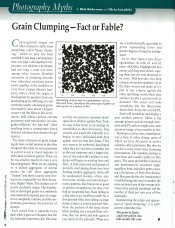Photo Engineer
Subscriber
Gentlemen;
In the OP, I posted figures from a work by Ross showing that although there is vertical movement in images due to development effects, he showed less than 2 microns of lateral movement of these same images. There was no clumping, just the illusion of clumps by viewing small, random particles down through the film which were separated vertically by quite some distance (on a micro scale).
Searching my copies of Photo Techniques Magazine from 2002 - 2008, I found that from about 2005 - 2008, Dickerson and Zawadski ran a series of articles about grain and granularity in their column called Photography Myths, and in the Jan - Feb 2008 issue published an article entitled "Grain Clumping - Fact or Fable". It was the only article of this type in my collection of this magazine, and since it appears to postdate Ian's referenced article, I assume it to be their last word!
In this article, quoted earlier, they debunk grain clumping with the same argument I presented from Ross in the OP, and dismiss micro reticulation without so much as a mention, simply by inferring that reticulation is a macro effect "the dry lake bed effect".
Since this article written by an expert in T-Max films (and other B&W films from EK) debunks this myth, I think the matter should be considered closed. Dick was one of the chief architects of the B&W film families in KRL up until he retired. We cannot have this both ways from the expert. He either agrees or disagrees with the postulate that grain clumping takes place. He says "doesn't happen". His comments, to me, represent all that need be said.
This is the author, on the subject Ian referred to, in the author's own words.
PE
In the OP, I posted figures from a work by Ross showing that although there is vertical movement in images due to development effects, he showed less than 2 microns of lateral movement of these same images. There was no clumping, just the illusion of clumps by viewing small, random particles down through the film which were separated vertically by quite some distance (on a micro scale).
Searching my copies of Photo Techniques Magazine from 2002 - 2008, I found that from about 2005 - 2008, Dickerson and Zawadski ran a series of articles about grain and granularity in their column called Photography Myths, and in the Jan - Feb 2008 issue published an article entitled "Grain Clumping - Fact or Fable". It was the only article of this type in my collection of this magazine, and since it appears to postdate Ian's referenced article, I assume it to be their last word!
In this article, quoted earlier, they debunk grain clumping with the same argument I presented from Ross in the OP, and dismiss micro reticulation without so much as a mention, simply by inferring that reticulation is a macro effect "the dry lake bed effect".
Since this article written by an expert in T-Max films (and other B&W films from EK) debunks this myth, I think the matter should be considered closed. Dick was one of the chief architects of the B&W film families in KRL up until he retired. We cannot have this both ways from the expert. He either agrees or disagrees with the postulate that grain clumping takes place. He says "doesn't happen". His comments, to me, represent all that need be said.
This is the author, on the subject Ian referred to, in the author's own words.
PE








 Also, if you read my posts I have said something appears to be going on. IDK what but it is NOT clumping or micro reticulation! D and Z address this and use an explanation similar to Ross.
Also, if you read my posts I have said something appears to be going on. IDK what but it is NOT clumping or micro reticulation! D and Z address this and use an explanation similar to Ross.





